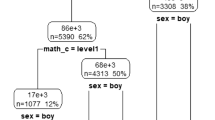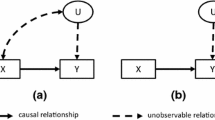Abstract
This paper proposes a structural analysis for generalized linear models when some explanatory variables are measured with error and the measurement error variance is a function of the true variables. The focus is on latent variables investigated on the basis of questionnaires and estimated using item response theory models. Latent variable estimates are then treated as observed measures of the true variables. This leads to a two-stage estimation procedure which constitutes an alternative to a joint model for the outcome variable and the responses given to the questionnaire. Simulation studies explore the effect of ignoring the true error structure and the performance of the proposed method. Two illustrative examples concern achievement data of university students. Particular attention is given to the Rasch model.
Similar content being viewed by others
References
Andersen, E.B. (1970). Asymptotic properties of conditional maximum-likelihood estimators. Journal of the Royal Statistical Society, Series B, 32, 283–301.
Andrich, D. (1988). Rasch models for measurement. Newbury Park: Sage Publications.
Bartholomew, D.J., & Knott, M. (1999). Latent variable models and factor analysis. London: Arnold Publishers.
Battauz, M., Bellio, R., & Gori, E. (2008). Reducing measurement error in student achievement estimation. Psychometrika, 73, 289–302.
Bock, R.D., & Aitkin, M. (1981). Marginal maximum likelihood estimation of item parameters: an application of an EM-algorithm. Psychometrika, 46, 443–459.
Carroll, R.J., & Wang, Y. (2008). Nonparametric variance estimation in the analysis of microarray data: A measurement error approach. Biometrika, 95, 437–449.
Carroll, R.J., Ruppert, D., Stefanski, L.A., & Crainiceanu, C.M. (2006). Measurement error in nonlinear models: a modern perspective (2nd ed.). London: Chapman and Hall.
Casella, G., & Berger, R.L. (2002). Statistical inference (2nd ed.). North Scituate: Duxbury Press.
Cheng, C.L., & Van Ness, J. (1999). Statistical regression with measurement error. London: Arnold Publishers.
Christensen, K.B. (2007). Latent covariates in generalized linear models: a Rasch model approach. In J.-L. Auget, N. Balakrishnan, M. Mesbah, & G. Molenberghs (Eds.), Advances in statistical methods for the health sciences (pp. 95–108). Boston: Birkhäuser.
Davison, A.C. (2003). Statistical models. Cambridge: Cambridge University Press.
Dempster, A.P., Laird, N.M., & Rubin, D.B. (1977). Maximum likelihood from incomplete data via the EM algorithm. Journal of the Royal Statistical Society, Series B, 39, 1–38.
Firth, D. (1993). Bias reduction of maximum likelihood estimates. Biometrika, 80, 27–38.
Fox, J.P., & Glas, A.W. (2003). Bayesian modeling of measurement error in predictor variables using item response theory. Psychometrika, 68, 169–191.
Higdon, R., & Schafer, D.W. (2001). Maximum likelihood computations for regression with measurement error. Computational Statistics & Data Analysis, 35, 283–299.
Hoijtink, H., & Boomsma, A. (1995). On person parameter estimation in the dichotomous Rasch model. In G.H. Fischer & I.W. Molenaar (Eds.), Rasch models: foundations, recent developments, and applications (pp. 53–68). New York: Springer.
Kosmidis, I., & Firth, D. (2009). Bias reduction in exponential family nonlinear models. Biometrika, 96, 793–804.
McCullagh, P., & Nelder, J.A. (1989). Generalized linear models (2nd ed.). London: Chapman and Hall.
Mislevy, R.T. (1985). Estimation of latent group effects. Journal of the American Statistical Association, 80, 993–997.
Monahan, J.F. (2001). Numerical methods of statistics. Cambridge: Cambridge University Press.
Rabe-Hesketh, S., Skrondal, A., & Pickles, A. (2004). Generalized multilevel structural equation modeling. Psychometrika, 69, 167–190.
R Development Core Team (2010). R: a language and environment for statistical computing. R Foundation for Statistical Computing, Vienna, Austria.
Rasch, G. (1960). Probabilistic models for some intelligence and attainment tests. Copenhagen: Danish Institute for Educational Research.
Schafer, D.W. (1987). Covariate measurement error in generalized linear models. Biometrika, 74, 385–391.
Schafer, D.W., & Purdy, K.G. (1996). Likelihood analysis for errors-in-variables regression with replicate measurements. Biometrika, 83, 813–824.
van der Linden, W.J., & Hambleton, R.K. (1997). Handbook of modern item response theory. New York: Springer.
Wang, Y., Ma, Y., & Carroll, R.J. (2009). Variance estimation in the analysis of microarray data. Journal of the Royal Statistical Society, Series B, 71, 425–445.
Warm, T.A. (1989). Weighted likelihood estimation of ability in item response theory. Psychometrika, 54, 427–450.
Author information
Authors and Affiliations
Corresponding author
Rights and permissions
About this article
Cite this article
Battauz, M., Bellio, R. Structural Modeling of Measurement Error in Generalized Linear Models with Rasch Measures as Covariates. Psychometrika 76, 40–56 (2011). https://doi.org/10.1007/s11336-010-9195-z
Received:
Revised:
Published:
Issue Date:
DOI: https://doi.org/10.1007/s11336-010-9195-z




